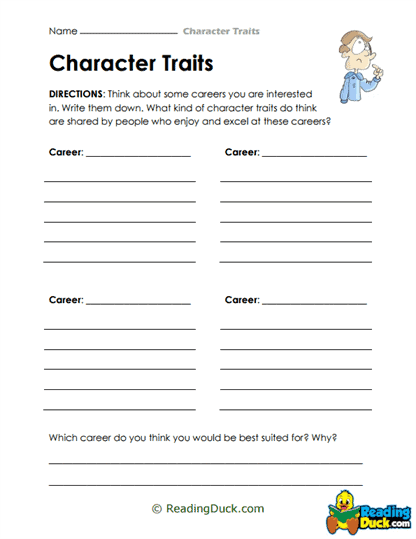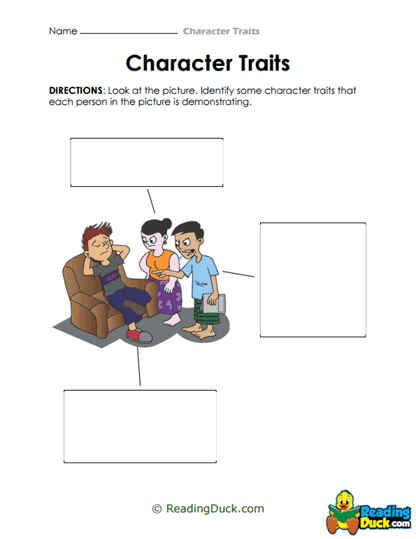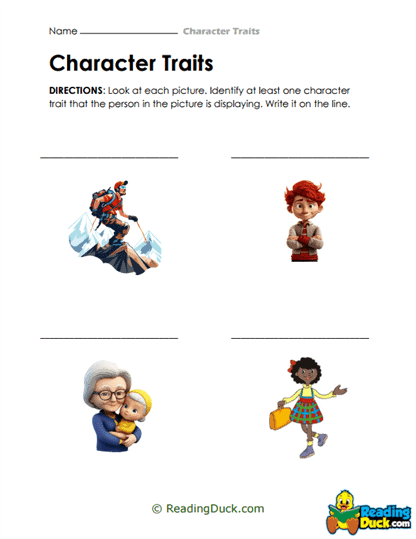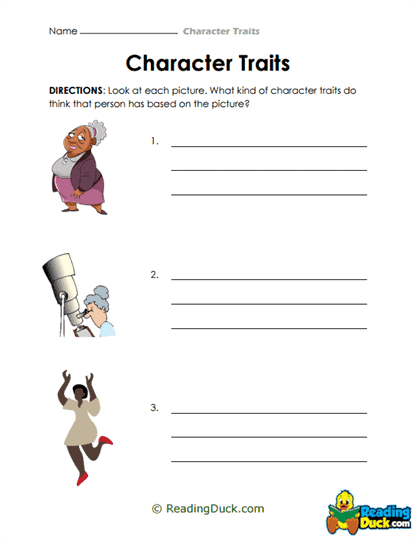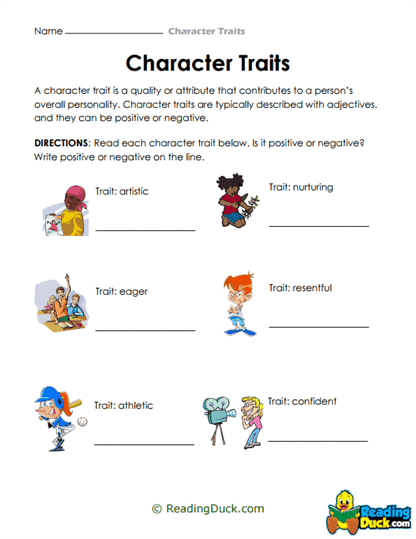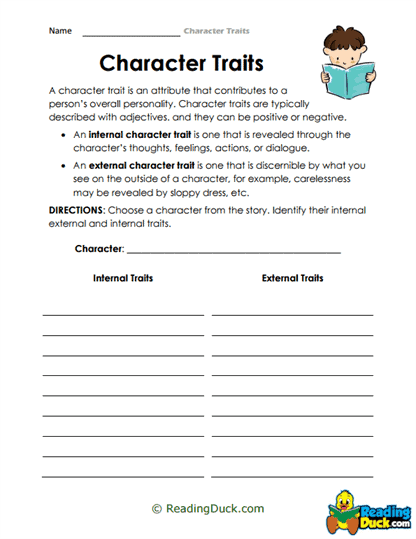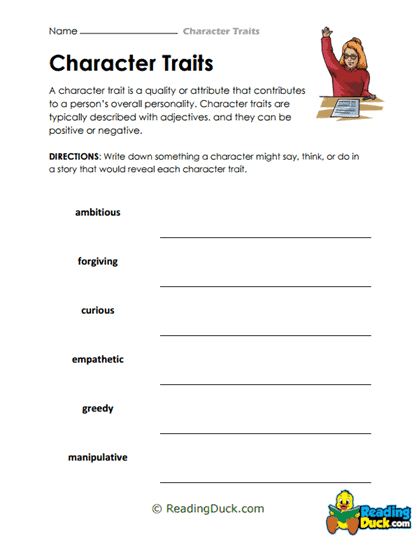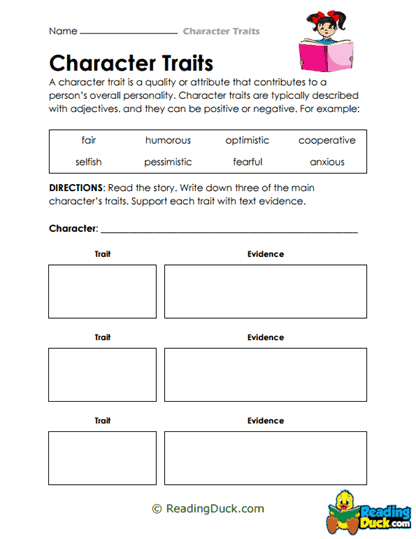Character Traits Worksheets
About Our Character Traits Worksheets
Our Character Traits Worksheets are thoughtfully designed to help students master the art of identifying and analyzing character traits in literature and writing. Understanding a character’s personality, motivations, and behaviors is a crucial part of reading comprehension and writing development. These worksheets guide students in exploring how characters’ actions, dialogue, and decisions reveal their inner qualities and contribute to the story. By engaging with these activities, students can develop a deeper understanding of characters and improve their descriptive writing skills.
Presented in easy-to-use PDF format, these worksheets are simple to view, download, and print. Each worksheet also includes a downloadable answer key, providing educators and parents with an efficient way to assess student progress and understanding. Whether you’re using these worksheets in a classroom or at home, they offer a valuable resource for enhancing students' analytical and writing abilities.
Understanding Character Traits in Writing
Character traits refer to the specific qualities, behaviors, and emotions that define a character’s personality in a story. These traits can be explicitly stated by the author or revealed through the character’s actions, dialogue, and interactions with other characters. Recognizing and analyzing character traits helps students understand not only the characters themselves but also the larger themes and messages within the text.
Some key components of character traits analysis include:
- Physical Traits vs. Personality Traits: Physical descriptions offer surface-level details, but personality traits—such as kindness, bravery, or selfishness—offer deeper insight into a character’s behavior and motivations.
- Direct vs. Indirect Characterization: Students learn how authors reveal traits directly (by telling) and indirectly (by showing through actions, thoughts, or dialogue). This distinction is vital for understanding how to analyze and describe characters in both reading and writing.
- Trait Development: Students explore how characters change over time and what events or circumstances lead to their growth or transformation. This helps deepen their comprehension of narrative arcs and themes.
- Character Motivation: Understanding what drives a character's actions or decisions is essential for analyzing their traits and behavior. Students learn to connect character motivations to the larger plot and themes of the story.
Our Character Traits Worksheets guide students in examining these elements, helping them break down how characters' personalities shape their actions and influence the direction of the story. By mastering this, students develop a sharper analytical lens for both reading and writing.
Strengthening Core Writing Skills with Character Traits Analysis
The Character Traits Worksheets are more than just an exploration of fictional personalities—they are a tool for building essential writing and analytical skills that students will use throughout their academic careers. By analyzing characters and describing their traits, students practice organizing their thoughts, using descriptive language, and supporting their ideas with evidence from the text. These skills are foundational for writing across all subjects and types of assignments.
Here’s how these worksheets build important writing skills:
- Descriptive Writing: By focusing on character traits, students enhance their ability to use specific, vivid language to describe characters’ personalities and actions, a skill that is crucial for narrative and creative writing.
- Logical Organization: To effectively analyze character traits, students must structure their thoughts coherently. These worksheets help them learn how to organize essays and responses around central ideas, improving their overall writing structure.
- Textual Evidence: Character analysis requires students to back up their observations with examples from the text. This teaches them how to use quotes and specific passages to support their interpretations, a key skill in both analytical writing and research papers.
- Critical Thinking: As students analyze character motivations and development, they practice higher-order thinking by connecting characters’ actions to broader themes and outcomes in the story.
By mastering these core writing skills, students not only improve their character analysis abilities but also develop the tools necessary for writing essays, reports, and creative narratives. This practice will help them excel in a variety of academic disciplines.
Incorporating Character Traits Worksheets into Lesson Plans
Our Character Traits Worksheets are flexible resources that can easily be integrated into broader lesson plans, whether you’re focusing on writing, reading comprehension, or literature analysis. These worksheets can be tailored to meet the specific needs of your curriculum, allowing educators and parents to customize them according to learning objectives and goals.
Here are a few ways to incorporate these worksheets into different types of lessons:
- In Literature Units: Use these worksheets to deepen students' understanding of characters in novels, short stories, or plays. Analyzing characters' traits can help students engage with the text more meaningfully, leading to richer discussions and deeper comprehension.
- In Writing Instruction: Character traits worksheets can be used to enhance creative writing lessons, helping students create more complex and dynamic characters for their own stories. This can lead to more nuanced and thoughtful writing.
- In Reading Comprehension Activities: These worksheets are ideal for developing students' ability to think critically about what they read. By analyzing character traits, students can improve their overall reading comprehension and better understand how characters drive the plot and connect to themes.
The worksheets can also be used as independent reading assignments or homework, providing students with structured practice in analyzing and describing characters. This flexibility makes them suitable for a wide range of educational settings.
Meeting Educational Standards and Supporting Academic Success
Our Character Traits Worksheets are designed to align with widely recognized educational standards, such as the Common Core State Standards and other local curriculum guidelines. This ensures that teachers can confidently use these worksheets to reinforce important literacy and writing skills that are essential for academic success.
These worksheets help students achieve proficiency in several key areas of educational standards:
- Analyzing characters and themes: Students learn to identify character traits and examine how they relate to the story’s themes and overall meaning.
- Using textual evidence: As students support their analysis with quotes and examples from the text, they practice essential skills in sourcing evidence and building well-supported arguments.
- Writing clear and structured responses: These worksheets encourage students to organize their thoughts logically, improving their ability to write coherent essays, reports, and responses.
Educators can integrate these worksheets into lesson plans knowing that they are helping students develop the critical skills needed for success in standardized tests, essays, and broader academic work. These resources reinforce the essential writing and reading comprehension skills outlined in many educational standards.
Promoting Critical Thinking and Deeper Analysis
Our Character Traits Worksheets go beyond simply identifying traits—they are designed to encourage deeper thinking and analysis. By challenging students to think critically about characters' actions, motivations, and development, these worksheets foster an analytical mindset that is essential for both literary analysis and broader academic success.
Students will be encouraged to:
- Examine character motivations: What drives the character to make certain decisions? How do these motivations reflect their personality or values?
- Connect characters to the plot: How do a character’s traits influence the events of the story? How do their actions impact other characters or the outcome of the narrative?
- Explore character development: How do characters change throughout the story? What events or interactions lead to these changes?
These exercises promote critical thinking by pushing students to make connections between characters, events, and themes, helping them to engage with texts on a deeper level. This not only improves their ability to analyze literature but also strengthens their critical thinking skills across all subjects.
Easy-to-Use Resources for Teachers and Parents
We know that educators and parents need practical resources that are easy to implement without requiring extensive preparation. Our Character Traits Worksheets are designed with ease of use in mind, offering clear instructions and minimal setup. The worksheets are available in PDF format, allowing for quick downloads, easy printing, and flexible use in various educational settings.
Each worksheet also comes with a downloadable answer key, providing educators and parents with an efficient way to assess students’ understanding of character traits and analysis. This saves time and ensures that educators can focus on active teaching and student engagement without spending extra hours on grading or lesson planning.
Whether used as part of a larger unit or as a standalone activity, these worksheets provide a valuable, time-saving tool that supports learning and skill development.
Conclusion
Our Character Traits Worksheets are an essential tool for helping students master character analysis while building critical writing and thinking skills. Available in PDF format with easy-to-use answer keys, these worksheets are ideal for classrooms, homeschooling, or independent study. They provide a structured yet flexible way for students to practice analyzing characters, understanding motivations, and improving their descriptive writing.
By focusing on core skills like textual evidence, logical organization, and critical thinking, these worksheets help students develop strong writing habits that contribute to their overall academic success. Whether integrated into literature units, writing lessons, or reading comprehension activities, these worksheets offer an effective, accessible resource for enhancing student learning and engagement.
